Golda Meir
Golda Meir[nb 1] (born Golda Mabovitch; May 3, 1898 – December 8, 1978) was an Israeli stateswoman, politician, teacher, and kibbutznik who served as the fourth Prime Minister of Israel.
Golda Meir | |
|---|---|
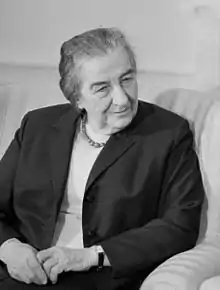 Golda Meir in March 1973 | |
| 4th Prime Minister of Israel | |
| In office March 17, 1969 – June 3, 1974 | |
| President | Zalman Shazar Ephraim Katzir |
| Preceded by | Yigal Allon (Acting) |
| Succeeded by | Yitzhak Rabin |
| Minister of Internal Affairs | |
| In office July 16, 1970 – September 1, 1970 | |
| Prime Minister | Herself |
| Preceded by | Haim-Moshe Shapira |
| Succeeded by | Yosef Burg |
| Minister of Foreign Affairs | |
| In office June 18, 1956 – January 12, 1966 | |
| Prime Minister | David Ben-Gurion Levi Eshkol |
| Preceded by | Moshe Sharett |
| Succeeded by | Abba Eban |
| Minister of Labour | |
| In office March 10, 1949 – June 19, 1956 | |
| Prime Minister | David Ben-Gurion |
| Preceded by | Mordechai Bentov (Acting) |
| Succeeded by | Mordechai Namir |
| Ambassador to Soviet Union | |
| In office 1948 – March 10, 1949 | |
| Prime Minister | David Ben-Gurion |
| Personal details | |
| Born | Golda Mabovitch May 3, 1898 Kiev, Russian Empire |
| Died | December 8, 1978 (aged 80) Jerusalem |
| Political party | Mapai (Before 1968) Labor Party (1968–1978) |
| Other political affiliations | Alignment (1969–1978) |
| Spouse(s) | Morris Meyerson
(m. 1917; died 1951) |
| Children | 2 |
| Alma mater | University of Wisconsin-Milwaukee |
| Signature |  |
Born in Kiev, she emigrated to the United States as a child with her family in 1906, and was educated there, becoming a teacher. After getting married, she and her husband emigrated to then Palestine in 1921, settling on a kibbutz. Meir was elected prime minister of Israel on March 17, 1969, after serving as Minister of Labour and Foreign Minister.[5] The world's fourth and Israel's first and only woman to hold the office of Prime Minister, she has been described as the "Iron Lady" of Israeli politics.[6] Former Prime Minister David Ben-Gurion used to call Meir "the best man in the government"; she was often portrayed as the "strong-willed, straight-talking, grey-bunned grandmother of the Jewish people."[7]
Meir resigned as prime minister in 1974, the year following the Yom Kippur War. She died in 1978 of lymphoma.[8]
Early life
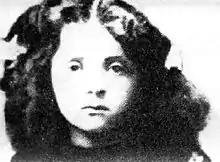
Golda Mabovitch was born in Kiev, Russian Empire (present-day Ukraine) on May 3, 1898 to Blume Neiditch (died 1951) and Moshe Mabovitch (died 1944), a carpenter. Meir wrote in her autobiography that her earliest memories were of her father boarding up the front door in response to rumours of an imminent pogrom. She had two sisters, Sheyna (1889–1972) and Tzipke (1902–1981), as well as five other siblings who died in childhood. She was especially close to Sheyna.
Moshe Mabovitch left to find work in New York City in 1903.[9] In his absence, the rest of the family moved to Pinsk to join her mother's family. In 1905, Moshe moved to Milwaukee, Wisconsin, in search of higher-paying work, and found employment in the workshops of the local railroad yard. The following year, he had saved up enough money to bring his family to the United States.
Golda's mother Blume Mabovitch ran a grocery store on Milwaukee's north side, where by the age of eight Golda had been put in charge of watching the store when her mother went to the market for supplies. Golda attended the Fourth Street Grade School (now Golda Meir School) from 1906 to 1912. A leader early on, she organized a fundraiser to pay for her classmates' textbooks. After forming the American Young Sisters Society, she rented a hall and scheduled a public meeting for the event. She graduated as valedictorian of her class.
At 14, she studied at North Division High School and worked part-time. Her employers included Schuster's department store and the Milwaukee Public Library.[10][11] Her mother wanted Golda to leave school and marry, but she declined. She bought a train ticket to Denver, Colorado, and went to live with her married sister, Sheyna Korngold. The Korngolds held intellectual evenings at their home, where Meir was exposed to debates on Zionism, literature, women's suffrage, trade unionism, and more. In her autobiography, she wrote: "To the extent that my own future convictions were shaped and given form ... those talk-filled nights in Denver played a considerable role." In Denver, she also met Morris Meyerson (also "Myerson"; December 17, 1893, Chicago, Illinois, US – May 25, 1951, Israel), a sign painter, whom she later married on December 24, 1917.[12]
Return to Milwaukee, Zionist activism, and teaching
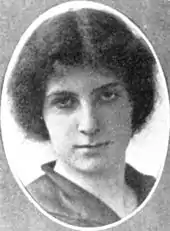
In 1913, Golda returned to North Division High, graduating in 1915. While there, she became an active member of Young Poale Zion, which later became Habonim, the Labor Zionist youth movement. She spoke at public meetings and embraced Socialist Zionism.[13]
She attended the teachers college Milwaukee State Normal School (now University of Wisconsin–Milwaukee) in 1916, and probably part of 1917. In 1917, she took a position at a Yiddish-speaking Folks Schule in Milwaukee. While at the Folks Schule, she came more closely into contact with the ideals of Labor Zionism. In 1913, she had begun dating Morris Meyerson (Myerson). She was a committed Labor Zionist and he was a dedicated socialist.[14] During this time, she also worked part-time at the Milwaukee Public Library.
When Golda and Morris married in 1917, settling in Palestine was her precondition for the marriage.[7] Golda had intended to make aliyah straight away, but her plans were disrupted when all transatlantic passenger services were canceled due to the entry of the United States into the First World War. She threw her energies into Poale Zion activities.[15] A short time after their wedding, she embarked on a fund-raising campaign for Poale Zion that took her across the United States.[7] The couple moved to Palestine in 1921, together with her sister Sheyna, and joined a kibbutz.[14]
Meir said in the 1975 edition of her autobiography My Life that
It is not only a matter, I believe, of religious observance and practice. To me, being Jewish means and has always meant being proud to be part of a people that has maintained its distinct identity for more than 2,000 years, with all the pain and torment that has been inflicted upon it.[16]
She strongly identified with Judaism culturally, but was an atheist in religious belief.[17][18][19]
Immigration to Mandatory Palestine
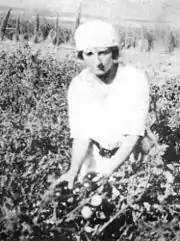
In the British Mandate of Palestine, Meir and her husband joined a kibbutz. Their first application to kibbutz Merhavia in the Jezreel Valley was rejected, but later they were accepted. Her duties included picking almonds, planting trees, working in the chicken coops, and running the kitchen. Recognizing her leadership abilities, the kibbutz chose her as its representative to the Histadrut, the General Federation of Labour.
In 1924, the couple left the kibbutz and lived briefly in Tel Aviv before settling in Jerusalem. There they had two children, a son Menachem (1924–2014) and a daughter Sarah (1926–2010).[20]
In 1928, Meir was elected secretary of Moetzet HaPoalot (Working Women's Council), which required her to spend two years (1932–34) as an emissary in the United States.[21] The children went with her, but Morris stayed in Jerusalem. Morris and Golda grew apart, but never divorced.[7] Morris died in 1951.
Histadrut activities
In 1934, when Meir returned from the United States, she joined the Executive Committee of the Histadrut and moved up the ranks to become the head of its Political Department. This appointment was important training for her future role in Israeli leadership.[22]
In July 1938, Meir was the Jewish observer from Palestine at the Évian Conference, called by President Franklin D. Roosevelt of the United States to discuss the question of Jewish refugees' fleeing Nazi persecution. Delegates from the 32 invited countries repeatedly expressed their sorrow for the plight of the European Jews, but outlined why their countries could not help by admitting the refugees.[23]
The only exception was the Dominican Republic, which pledged to accept 100,000 refugees on generous terms.[24] Meir was disappointed at the outcome and she remarked to the press, "There is only one thing I hope to see before I die and that is that my people should not need expressions of sympathy anymore."[12]
Prestate political role
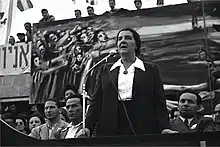
In June 1946, the British arrested many leaders of the Zionist Yishuv (see Black Sabbath). Meir took over as acting head of the Political Department of the Jewish Agency during the incarceration of Moshe Sharett. Thus she became the principal negotiator between the Jews in Palestine and the British Mandatory authorities. After his release, Sharett went to the United States to attend talks on the UN Partition Plan, leaving Meir to head the Political Department until the establishment of the state in 1948.[22]
In January 1948, the treasurer of the Jewish Agency was convinced that Israel would not be able to raise more than seven to eight million dollars from the American Jewish community. Meir traveled to the United States, and she raised $50,000,000, which was used to purchase arms in Europe for the young country. Ben-Gurion wrote that Meir's role as the "Jewish woman who got the money which made the state possible" would go down one day in the history books.[7]
On May 10, 1948, four days before the official establishment of Israel, Meir traveled to Amman, disguised as an Arab woman, for a secret meeting with King Abdullah I of Transjordan, at which she urged him not to join the other Arab countries in attacking the Jews. Abdullah asked her not to hurry to proclaim a state. Meir replied: "We've been waiting for 2,000 years. Is that hurrying?"[25]
As the head of the Jewish Agency Political Department, Meir called the mass exodus of Arabs before the War of Independence in 1948 "dreadful", and she likened it to what had befallen the Jews in Nazi-occupied Europe.[26]
Diplomatic and ministerial career

Meir was one of 24 signatories (including two women) of the Israeli Declaration of Independence on May 14, 1948. She later recalled, "After I signed, I cried. When I studied American history as a schoolgirl and I read about those who signed the U.S. Declaration of Independence, I couldn't imagine these were real people doing something real. And there I was sitting down and signing a declaration of establishment." Israel was attacked the next day by the joint armies of neighboring countries in what became the 1948 Arab–Israeli War. During the war, Israel stopped the combined Arab assault, and then it launched a series of military offensives to defeat the invading Arab armies and to end the war.
Minister Plenipotentiary to Moscow

Carrying the first Israeli-issued passport,[27][28] Meir was appointed Israel's minister plenipotentiary to the Soviet Union, with her term beginning on September 2, 1948, and ending in March 1949.[29] At the time, good relations with the Soviet Union were important for Israel's ability to secure arms from Eastern European countries for the struggle that accompanied its independence. In turn, Joseph Stalin and Soviet Foreign Minister Vyacheslav Molotov sought to cultivate a strong relationship with Israel as a means of furthering the Soviet position in the Middle East.[30] Soviet–Israeli relations were complicated by Soviet policies against religious institutions and nationalist movements, made manifest in actions to shut down Jewish religious institutions as well as the ban on Hebrew language study and the prohibition of promoting emigration to Israel.[31]
During her brief stint in the USSR, Meir attended Rosh Hashanah and Yom Kippur services at the Moscow Choral Synagogue.[29] She was mobbed by thousands of Russian Jews chanting her name. The Israeli 10,000-shekel banknote issued in November 1984 bore a portrait of Meir on one side and the image of the crowd that turned out to cheer her in Moscow on the other.[32]
Labor minister
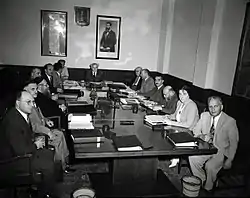
In 1949, Meir was elected to the Knesset as a member of Mapai and served continuously until 1974. From 1949 to 1956, she served as Minister of Labour. While serving in this position, Meir carried out welfare state policies, orchestrated the integration of immigrants into Israel's workforce,[33] and introduced major housing and road construction projects.[34] From 1949 to 1956, 200,000 apartments and 30,000 houses were built, large industrial and agricultural developments were initiated, and new hospitals, schools, and roads were built.[35] Meir also helped in the development of the National Insurance Act of 1954, which introduced Israel's system of social security, together with the country's maternity benefits programme and other welfare measures.[36]
In 1955, on Ben-Gurion's instructions, she stood for the position of mayor of Tel Aviv. She lost by the two votes of the religious bloc who withheld their support on the grounds that she was a woman.[37] (Mayors then were elected by the city council, rather than elected directly as has been the case since 1978, see Municipal elections in Israel.)[38]
Foreign minister
In 1956, she became Foreign Minister under Prime Minister David Ben-Gurion. Her predecessor, Moshe Sharett, had asked all members of the foreign service to take a Hebrew surname. Upon her appointment as foreign minister, she shortened "Meyerson/Myerson" to "Meir", which means "illuminate". As foreign minister, Meir promoted ties with the newly established states in Africa in an effort to gain allies in the international community.[34] She also believed that Israel had experience in nation-building that could be a model for the Africans. In her autobiography, she wrote:
"Like them, we had shaken off foreign rule; like them, we had to learn for ourselves how to reclaim the land, how to increase the yields of our crops, how to irrigate, how to raise poultry, how to live together, and how to defend ourselves." Israel could be a role model because it "had been forced to find solutions to the kinds of problems that large, wealthy, powerful states had never encountered".[39]
Meir's first months as Foreign Minister coincided with the Suez Crisis, which is also known as the Second Arab-Israeli War, the Tripartite aggression (in Arab countries), Sinai Campaign, and Operation Kadesh (by the Israeli government)[40] and others. Israel invaded Egypt in late 1956, followed by Britain and France. The aims were to regain Western control of the Suez Canal, remove Egyptian president Nasser, and provide a more secure western border and freedom of navigation through the Straits of Tiran for Israel. Meir was involved in planning and coordination with the French government and military prior to the start of military action.[41] During United Nations debates about the crisis, Meir took charge of the Israeli delegation.[42] After the fighting had started, the United States, the Soviet Union, and the United Nations forced the three invaders to withdraw. As a result of the conflict, the United Nations created the UNEF military peacekeeping force to police the Egyptian–Israeli border.
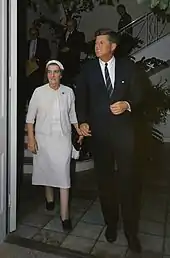
On October 29, 1957, Meir's foot was slightly injured when a Mills bomb was thrown into the debating chamber of the Knesset. David Ben-Gurion and Moshe Carmel were more seriously injured. The attack was carried out by 25-year-old Moshe Dwek. Born in Aleppo, his motives were attributed to a dispute with the Jewish Agency, but he was described as being "mentally unbalanced".[43]
In 1958, Meir was recorded as having praised the work of Pope Pius XII on behalf of the Jewish people shortly after the pontiff's death. Pope Pius's legacy as a wartime pope has been controversial into the 21st century.[44]
The same year, during the wave of Jewish migration from Poland to Israel, Meir sought to prevent disabled and sick Polish Jews from immigrating to Israel. In a letter sent to Israel's ambassador in Warsaw, Katriel Katz, she wrote:
A proposal was raised in the coordination committee to inform the Polish government that we want to institute selection in aliyah, because we cannot continue accepting sick and handicapped people. Please give your opinion as to whether this can be explained to the Poles without hurting immigration."[45]
In the early 1960s, Meir was diagnosed with lymphoma. In January 1966, she retired from the Foreign Ministry, citing exhaustion and ill health. She soon returned to public life as secretary-general of Mapai, supporting Prime Minister Levi Eshkol in party conflicts.[34]
Premiership
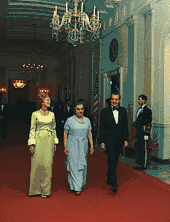
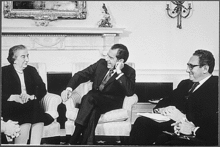
After Levi Eshkol's sudden death on February 26, 1969, the party elected Meir as his successor.[46] Meir came out of retirement to take office on March 17, 1969, serving as prime minister until 1974. Meir maintained the national unity government formed in 1967 after the Six-Day War, in which Mapai merged with two other parties (Rafi and Ahdut HaAvoda) to form the Israeli Labor Party.[34]
Six months after taking office, Meir led the reconfigured Alignment, comprising Labor and Mapam, into the 1969 general election. The Alignment managed what is still the best showing for a single party or faction in Israeli history, winning 56 seats. This is the only time that a party or faction has approached winning an outright majority in an election. The national unity government was retained.
In 1969 and the early 1970s, Meir met with many world leaders to promote her vision of peace in the Middle East, including Richard Nixon (1969), Nicolae Ceaușescu (1972) and Pope Paul VI (1973). In 1973, she hosted the chancellor of West Germany, Willy Brandt, in Israel.[34]
In August 1970, Meir accepted a U.S. peace initiative that called for an end to the War of Attrition and an Israeli pledge to withdraw to "secure and recognized boundaries" in the framework of a comprehensive peace settlement. The Gahal party quit the national unity government in protest, but Meir continued to lead the remaining coalition.[47]
On February 28, 1973, during a visit in Washington, D.C., Golda agreed with Henry Kissinger's peace proposal based on "security versus sovereignty": Israel would accept Egyptian sovereignty over all Sinai, while Egypt would accept Israeli presence in some of Sinai's strategic positions.[48][49][50][51][52]
Munich Olympics
In the wake of the Munich massacre at the 1972 Summer Olympics, Meir appealed to the world to "save our citizens and condemn the unspeakable criminal acts committed".[53] Outraged at the perceived lack of global action, she ordered the Mossad to hunt down and assassinate suspected leaders and operatives of Black September and the PFLP.[54]
Dispute with Austria
During the 1970s, about 200,000 Soviet Jewish emigrants were allowed to leave the Soviet Union for Israel by way of Austria. When seven of these emigrants were taken hostage at the Austria–Czechoslovakia border by Palestinian militants in September 1973, the Chancellor of Austria, Bruno Kreisky, closed the Jewish Agency's transit facility in Schönau, Austria. A few days later in Vienna, Meir tried to convince Kreisky to reopen the facility by appealing to his own Jewish origin, and described his position as "succumbing to terrorist blackmail". Kreisky did not change his position, so Meir returned to Israel, infuriated.[55] A few months later, Austria opened a new transition camp.[56]
Yom Kippur War
In the days leading up to the Yom Kippur War, Israeli intelligence could not conclusively determine that an attack was imminent. However, on October 5, 1973, Meir received official news that Syrian forces were massing on the Golan Heights. The prime minister was alarmed by the reports, and believed that the situation was similar to what preceded the Six-Day War. Her advisers, however, assured her not to worry, saying that they would have adequate notice before a war broke out. This made sense at the time; after the Six-Day War, most Israelis felt it unlikely that the Arabs would attack. Consequently, although the Knesset passed a resolution granting her power to demand a full-scale call-up of the military (instead of the typical cabinet decision), Meir did not mobilize Israel's forces early. Soon, though, the threat of war became very clear. Six hours before the outbreak of hostilities, Meir met with Minister of Defense Moshe Dayan and general David Elazar. While Dayan continued to argue that war was unlikely and favored calling up the air force and only two divisions, Elazar advocated full-scale army mobilization and the launch of a full-scale preemptive strike on Syrian forces.[57]
Meir approved full-scale mobilizing but sided with Dayan against a preemptive strike, citing Israel's need for foreign aid. She believed that Israel could not depend on European countries to supply Israel with military equipment, and the only country that might come to Israel's assistance was the United States. Fearing that the United States would be wary of intervening if Israel were perceived as initiating the hostilities, Meir decided on October 6 against a preemptive strike. She made it a priority to inform Washington of her decision. U.S. Secretary of State Henry Kissinger later confirmed Meir's assessment by stating that if Israel had launched a preemptive strike, Israel would not have received "so much as a nail".[58][59]
Resignation
Following the Yom Kippur War, Meir's government was plagued by infighting and questions over Israel's lack of preparation for the war. The Agranat Commission appointed to investigate the war cleared Meir of "direct responsibility". It said about her actions on Yom Kippur morning:
She decided wisely, with common sense and speedily, in favour of the full mobilization of the reserves, as recommended by the chief-of-staff, despite weighty political considerations, thereby performing a most important service for the defence of the state.[58]
Her party won the elections in December 1973, but Meir resigned on April 11, 1974. She believed that was the "will of the people" and that she had served enough time as premier. She believed the government needed to form a coalition. She said, "Five years are sufficient ... It is beyond my strength to continue carrying this burden."[58][60] Yitzhak Rabin succeeded her on June 3, 1974.
In 1975, Meir published her autobiography, My Life.[58][61] On November 19, 1977, President of Egypt Anwar Sadat became the first Arab leader to visit Israel in an official capacity when he met Israeli Prime Minister Menachem Begin, and spoke before the Knesset in Jerusalem about his views on how to achieve a comprehensive peace in the Arab–Israeli conflict. He recommended the full implementation of UN Resolutions 242 and 338. On November 21, President Sadat again drove to the Knesset for meetings with the various Israeli Knesset factions. Meir was the first to speak for the Labor Party. She congratulated Sadat as the first Arab leader to come to Israel for the sake of the next generations' avoiding war. Meir praised Sadat for his courage and vision, and expressed the hope that while many differences remained to be resolved, that vision would be achieved in a spirit of mutual understanding.[62][63]
Death
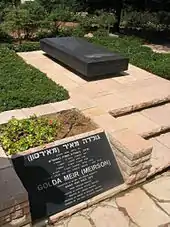
On December 8, 1978, Meir died of lymphatic cancer in Jerusalem at the age of 80. Meir was buried on Mount Herzl in Jerusalem.[64]
Awards and recognition
In 1974, Meir was awarded the honor of World Mother by American Mothers.[65] In 1974 Meir was awarded the James Madison Award for Distinguished Public Service by Princeton University's American Whig–Cliosophic Society.[66]
In 1975, Meir was awarded the Israel Prize for her special contribution to society and the State of Israel.[58][67]
In 1985, Meir was inducted into the Colorado Women's Hall of Fame.[68]
Legacy
Portrayals in film and theater
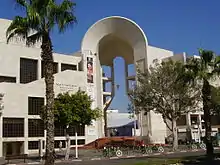
Meir's story has been the subject of many fictionalized portrayals. In 1977, Anne Bancroft played Meir in William Gibson's Broadway play Golda. The Australian actress Judy Davis played a young Meir in the television film A Woman Called Golda (1982), opposite Leonard Nimoy. Ingrid Bergman played the older Meir in the same film. Actress Colleen Dewhurst portrayed Meir in the 1986 TV movie Sword of Gideon.[69]
In 2003, American Jewish actress Tovah Feldshuh portrayed her on Broadway in Golda's Balcony, Gibson's second play about Meir's life. The play was controversial for implying that Meir considered using nuclear weapons during the Yom Kippur War. Valerie Harper portrayed Meir in the touring company production and in the film version of Golda's Balcony.[70] In 2005 actress Lynn Cohen portrayed Meir in Steven Spielberg's film Munich.
Tovah Feldshuh assumed the role of Meir again in the 2006 English-language French movie O Jerusalem. She was played by the Polish actress Beata Fudalej in the 2009 dramatic film The Hope directed by Márta Mészáros.[71]
Commemoration

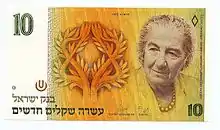
- Golda Meir School, Milwaukee, Wisconsin[72]
- Golda Meir School, in Barra da Tijuca, Rio de Janeiro, Brazil[73]
- Golda Meir Library, University of Wisconsin–Milwaukee, Wisconsin[74]
- Golda Meir Boulevard, Jerusalem, Israel (and various other streets, neighborhoods and schools in Israel)
- Golda Meir Center for the Performing Arts – home to the Israeli Opera and the Cameri Theater, Tel Aviv[75]
- Bust of Golda Meir at Golda Meir Square, New York City[76]
- Golda Meir Center for Political Leadership at Metropolitan State University of Denver[77]
- Golda Meir House, Denver, Colorado[12][78]
- Golda Meir House, Newton, Massachusetts[79]
Cultural references
In Israel, the term "Golda's shoes" (na'alei Golda) has become a reference to the sturdy orthopedic shoes that Golda favored. These shoes were also supplied to women soldiers in the Israel Defense Forces from its foundation to 1987.[80]
Published works
Notes
References
- "Meir". Collins English Dictionary. HarperCollins. Retrieved June 26, 2019.
- "Meir, Golda". Lexico UK Dictionary. Oxford University Press. Retrieved June 26, 2019.
- "Meir". Merriam-Webster Dictionary. Retrieved June 26, 2019.
- "Golda Meir: An Outline of a Unique Life: A Chronological Survey of Gola Meir's Life and Legacy". The Golda Meir Center for Political Leadership (Metropolitan State University of Denver). Retrieved February 20, 2014. Reference on name pronunciation (see "1956").
- Golda Meir becomes Israeli Prime Minister, History Today
- Golda Meir, a BBC News profile.
- Mother of a nation, but not much of a mother Haaretz, July 7, 2008
- Yitzhak Shargil and Gil Sedan. "State Funeral Will Be Held Tuesday for Golda Meir Who Died Friday at the Age of 80." Jewish Telegraphic Agency December 11, 1978.
- "Golda Meir's American Roots". Ajhs.org. Archived from the original on April 26, 2011. Retrieved June 27, 2016.CS1 maint: unfit URL (link)
- Jim Higgins (November 27, 2017). "Author recounts Golda Meir's career as a leader, which began as a schoolgirl in Milwaukee". Milwaukee Journal Sentinel. Retrieved November 27, 2017.
- "Goldie Mabowehz (Golda Meir), from the Milwaukee Public Library to Prime Minister of Israel". Milwaukee Public Library. March 15, 2017. Retrieved November 27, 2017.
- Golda Meir: An Outline Of A Life Metropolitan State College of Denver, mscd.edu; accessed November 22, 2015.
- "Golda Meir". Jewish Virtual Library. Retrieved December 8, 2017.
- "Golda Meir (1898–1978)". University of Wisconsin-Milwaukee. Retrieved December 8, 2017.
- Burkett 2008, p. 37.
- Golda Meir (1975). My Life. Weidenfeld & Nicolson. p. 459. ISBN 0860073947.
- Giulio Meotti (2011). A New Shoah: The Untold Story of Israel's Victims of Terrorism. p. 147. ISBN 9781459617414. "Even atheist and socialist Israelis like David Ben-Gurion, Moshe Dayan, and Golda Meir were marked by the stories and legends of King David and the prophets. In other words, their lives had been shaped by Hebron."
- Fischer, Raymond Robert. Israel My Inheritance: Persecuted Messianic Jews Cry Out for Justice and Reform. Lake Mary: Creation House, 2011. Print.
- See Emma Goldman, "The Philosophy of Atheism", in Christopher Hitchens, ed., The Portable Atheist (Philadelphia: Da Capo Press, 2007), 129–133; Golda Meir is quoted by Jonathan Rosen in "So Was It Odd of God?", The New York Times, December 14, 2003.
- "Golda Meir | Jewish Women's Archive". jwa.org. Retrieved June 12, 2018.
- Golda Meir, Encyclopedia of Zionism and Israel, ed. Raphael Patai, New York, 1971, vol. II, pp. 776–77
- "Golda Meir", Encyclopaedia Judaica, Keter, 1972, Jerusalem, vol. 11, pp. 1242–45
- Flüchtlingskonferenz von Évian 1938, Als die Welt sich abwandte, Der Spiegel, July 6, 2018. (in German)
- "MJHnyc.org" (PDF). Archived from the original (PDF) on September 29, 2011. Retrieved September 2, 2011.
- "Golda Meir: Peace and Arab Acceptance Were Goals of Her 5 Years as Premier". New York Times. December 9, 1978.
- Margolick, David. "Endless War" New York Times, May 4, 2008
- "Golda". The Emery/Weiner School. Archived from the original on July 26, 2011.
- Pine, Dan. "Golda Meir's life was devoted to building Zionism". San Francisco Jewish Community Publications. Archived from the original on August 26, 2012. Retrieved July 15, 2005.
- Yossi Goldstein, "Doomed to Fail: Golda Meir's Mission to Moscow (Part 1)", The Israel Journal of Foreign Affairs Vol. 5 No. 3 (September 2011), p. 131
- Yossi Goldstein, "Doomed to Fail: Golda Meir's Mission to Moscow (Part 1)", The Israel Journal of Foreign Affairs Vol. 5 No. 3 (September 2011), p. 134 and 137
- Goldstein (Sept 2011), "Doomed to Fail", p. 138
- Call Uncle Sam Archived July 26, 2011, at the Wayback Machine News Behind the News, June 10, 2001
- "Biography". Morim Madrichim. Retrieved January 31, 2013.
- "Golda Meir", Encyclopædia Britannica, Micropædia, 1974, 15th edition, p. 762
- Flatt, J.M.M. (2012). Powerful Political Women: Stirring Biographies of Some of History's Most Powerful Women. iUniverse. p. 172. ISBN 9781462068197. Retrieved December 3, 2014.
- Reich, B. (1990). Political Leaders of the Contemporary Middle East and North Africa: A Biographical Dictionary. Greenwood Press. p. 329. ISBN 9780313262135. Retrieved December 3, 2014.
- My Life. p. 232. She 'wasn't very pleased' with B.G. and was 'enraged' by the religious bloc.
- Dana Blander, "Elections for the Local Authority – Who, What, When, Where and How?", first published in Parliament, November 5, 2008, posted at Israel Democratic Institute; accessed August 21, 2018
- Golda Meir, My Life, (New York: Dell Publishing, 1975), pp. 308–09
- The Arab-Israeli Wars, Israel Ministry of Foreign Affairs. Retrieved March 21, 2015
- Israel Studies An Anthology: The Sinai War and Suez Crisis, 1956–7, Motti Golani, 2010, Jewish Virtual Library. Retrieved March 21, 2015
- Golda Meir: An Outline of a Unique Life – A Chronological Survey of Gola Meir's Life and Legacy, Gold Meir Center for Political Leadership, Metropolitan State University of Denver. Retrieved March 21, 2015
- Robert William St. John, Ben Gurion. Jarrods Publishers (Hutchinson Group), London. 1959. pp. 304–306.
- "Jewish Gratitude for the Help of Pope Pius XII Who helped them against the perverse regime of the Nazis". Catholic Apologetics. Retrieved September 2, 2011.
- "Golda Meir wanted to keep sick Poles from making aliyah". Jewish Telegraphic Agency. December 9, 2009. Archived from the original on December 12, 2009.
- 1969: Israel elects first female leader BBC News
- "Golda Meir" Encyclopaedia Judaica, Keter, Jerusalem, 1972, pp. 1242–44.
- Yitzhak Rabin (1996). The Rabin Memoirs. University of California Press. p. 215. ISBN 978-0-520-20766-0.
security versus sovereignty ... Israel would have to accept Egyptian sovereignty over all the Sinai, while Egypt, in turn, would have to accept Israeli military presence in certain [Sinai] strategic positions.
- Henry Kissinger (May 24, 2011). Years of Upheaval. Simon and Schuster. pp. 252–. ISBN 978-1-4516-3647-5.
"She (Golda Meir) would be prepared to have me (Kissinger) continue to explore in private with Hafiz Ismail (the Egyptian delegate) some general principles of an overall settlement" this hint is compatible with Rabin description of Golda readiness for recognizing Egyptian sovereignty in Sinai
- P.R. Kumaraswamy (January 11, 2013). Revisiting the Yom Kippur War. Routledge. pp. 105–. ISBN 978-1-136-32888-6.
In February 1973, Kissinger held talks with Sadat's National Security Advisor, Hafez Ismail. ... memoirs that Kissinger told him that, on the basis of his conversations with Hafez Ismail, Egypt might be ready to start negotiating if Israel acknowledged Egyptian sovereignty over all of Sinai. Rabin consulted with Prime Minister Golda Meir and told Kissinger that Israel authorized him to explore this approach.
- Richard Bordeaux Parker (2001). The October War: A Retrospective. University Press of Florida. pp. 64–. ISBN 978-0-8130-1853-9.
Dinits evidence
- Steven L. Spiegel (October 15, 1986). The Other Arab-Israeli Conflict: Making America's Middle East Policy, from Truman to Reagan. University of Chicago Press. pp. 237–. ISBN 978-0-226-76962-2.
based on Rabin
- Hostages killed in gun battle Daily Telegraph, September 5, 1972
- Morris, B. (2001) [1999]. Righteous Victims: A History of the Zionist–Arab Conflict, 1881–2000. New York: Vintage Books. ISBN 0-679-74475-4.
- Avner 2010, p. 219.
- "(German)". Historisch.apa.at. September 28, 1973. Archived from the original on August 20, 2011. Retrieved September 2, 2011.
- Interview with Abraham Rabinovich: The Yom Kippur War as a Turning Point, History News Network
- Meir, Golda (1975). My Life. G. P. Putnam's Sons.
- "The October War and U.S. Policy", National Security Archive, declassified archival records, George Washington University
- Biography of Golda Meir, Zionism and Israel
- Golda Meir Archived March 24, 2006, at Archive.today Virtual Jerusalem
- Remarks by Golda Meir to President Sadat in the Knesset, Jewish Virtual Library
- "Three years too late, Golda Meir understood how war could have been avoided", Times of Israel
- Golda Meir: a political biography
- "Past National Mothers of The Year". Archived from the original on March 23, 2011.
- "UN Secretariat Item: Letter – The American Whig-Cliosophic Society : James Madison Award for Distinguished Public Service – 1974 – Golda Meir" (PDF). Archives-trim.un.org. Archived from the original (PDF) on December 26, 2012. Retrieved November 25, 2012.
- "Israel Prize Official Site – Recipients in 1975 (in Hebrew)".
- Colorado Women's Hall of Fame, Golda Meir
- "Filmography for Colleen Dewhurst". Turner Classic Movies. Retrieved February 1, 2018.
- Gans, Andrew (October 10, 2007). "'Golda's Balcony' Film, with Valerie Harper, Begins Engagement at Quad Cinema Oct. 10". Playbill. Retrieved February 1, 2018.
- Mészáros wraps production on historical drama The Hope Screen Daily. February 26, 2009
- Fourth Street School Wisconsin Historical Society
- "Unidades Escolares". Government of Rio de Janeiro. Retrieved March 15, 2018.
- Hubbard, John. "Frequently Asked Questions: Library Information". University of Wisconsin-Milwaukee. Retrieved March 15, 2018.
- "Golda Center – Tel Aviv Performing Arts Center". Zeev Matar Ltd. – זאב מטר בע"מ. Retrieved March 15, 2018.
- Jerold S. Kayden; New York (N.Y.). Dept. of City Planning; The Municipal Art Society of New York (November 6, 2000). Privately Owned Public Space: The New York City Experience. John Wiley & Sons. p. 126. ISBN 978-0-471-36257-9.
- "A Chronological Survey of Gola Meir's Life and Legacy". Mscd.edu. Retrieved September 2, 2011.
- Golda Meir House U.S. Library of Congress
- "Golda Meir House". Jewish Community Housing for the Elderly. Retrieved March 15, 2018.
- "Israel's Women GIs Kick Off 'Golda Shoes'". Los Angeles Times. Tel Aviv. AP. May 11, 1987. Retrieved October 3, 2013.
Sources
- Avner, Yehuda (2010). The Prime Ministers: An Intimate Narrative of Israeli Leadership. Toby Press. ISBN 978-1-59264-278-6. OCLC 758724969.
- Burkett, Elinor (2008). Golda Meir: The Iron Lady of the Middle East. Gibson Square. ISBN 978-1-906142-13-1.
Further reading
- Agrees, Elijahu (1969). Golda Meir: Portrait of a Prime Minister. Sabra Books. ISBN 0-87631-020-X.
- Fallaci, Oriana (1976). Interview With History. Houghton Mifflin. ISBN 0-395-25223-7.
- Klagsbrun, Francine (2017). Lioness: Golda Meir and the Nation of Israel. Schocken Books. ISBN 978-0-80524-237-9.
- Martin, Ralph G. (1988). Golda Meir: The Romantic Years. Ivy Books. ISBN 0-8041-0536-7.
- Meir, Menahem (1983). My Mother Golda Meir: A Son's Evocation of Life With Golda Meir. Arbor House Publishing Company. ISBN 0-87795-415-1.
- Skard, Torild (2014) "Golda Meir" in Women of Power – Half a century of female presidents and prime ministers worldwide. Bristol: Policy Press, ISBN 978-1-44731-578-0.
- Syrkin, Marie (1969). Golda Meir: Israel's Leader. Putnam.
- Syrkin, Marie (1963). Golda Meir: Woman with a Cause.
External links
| Wikiquote has quotations related to: Golda Meir |
| Wikimedia Commons has media related to Golda Meir. |
- Golda Meir on the Knesset website
- Golda Meir at the Israeli Ministry of Foreign Affairs
- Meir, Golda (née Mabovitch; 1898–1978) at the Jewish Agency For Israel
- Women's International Center
- The short film Golda Meir Interview (Reel 1 of 2) (1973) is available for free download at the Internet Archive
- The short film Golda Meir Interview (Reel 2 of 2) (1973) is available for free download at the Internet Archive
- Video Lecture on Golda Meir by Dr. Henry Abramson
- Prime Minister Golda Meir, Exhibition in the IDF&Defense establishment archives
- Golda Meir Personal Manuscripts, Shapell Manuscript Foundation
- The Golda Meir Mount Carmel International Training Center (MCTC) – established in 1961 to assist in the training of women engaged in community work in the newly emerging states in Africa and Asia
| Political offices | ||
|---|---|---|
| Preceded by Moshe Sharett |
Minister of Foreign Affairs 1956–1966 |
Succeeded by Abba Eban |
| Preceded by Yigal Allon Acting |
Prime Minister of Israel 1969–1974 |
Succeeded by Yitzhak Rabin |
| Preceded by Haim-Moshe Shapira |
Minister of Internal Affairs 1970 |
Succeeded by Yosef Burg |
| Party political offices | ||
| Preceded by Yigal Allon Acting |
Leader of the Alignment 1969–1974 |
Succeeded by Yitzhak Rabin |